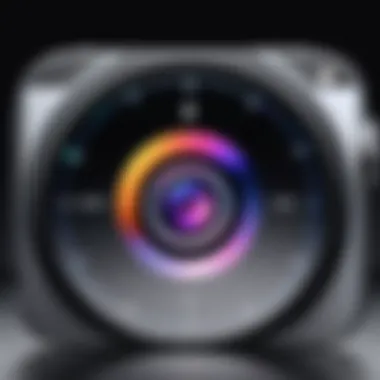How to Create Stunning Slow Motion Videos on iPhone


Intro
Slow motion video has become a popular feature among smartphone users. It allows for a deeper appreciation of movements that are often too quick to notice. The iPhone, with its advanced camera capabilities, provides a sophisticated platform to create stunning slow-motion videos. This article delves into the various technical aspects of how users can effectively utilize their iPhones for slow-motion effects.
Overview of the Technology
The iPhone comes equipped with a range of specifications that enhance its video recording functionality. Current models, like the iPhone 13 and 14, are capable of recording in slow motion at 120 FPS and 240 FPS. These frame rates are optimal for achieving smooth playback that highlights intricate details.
Key specifications
- Camera Quality: Both the rear and front cameras offer various resolution options, maximizing video quality.
- Frame Rates: Users can select either 120 FPS or 240 FPS for different slow-motion effects.
- Storage Capacity: Higher storage models can accommodate larger video files resulting from slow-motion recordings.
Unique Selling Points
The iPhone's native slow-motion capabilities stand out due to ease of use and integrations with editing features. Users appreciate the seamless transition from recording to editing within the same app. This integration allows for quick adjustments and sharing options, making it highly user-friendly. The combination of accessibility and advanced technology positions the iPhone as a leader in mobile photography.
Practical Application
Understanding how to effectively use the slow-motion feature requires familiarity with the iPhone camera settings. When navigating to the camera app, select the 'Slo-Mo' option. This choice automatically adjusts the camera’s frame rate to the selected speed. Holding steady during recording is crucial to capturing clear footage, especially at higher frame rates.
Once you have recorded your slow-motion video, the editing process begins. This often involves trimming the footage to highlight specific moments of interest, adding sound effects or music to enhance the viewing experience. Users can edit directly in the Photos app or opt for third-party video editing software for more complex edits.
"The hallmark of compelling slow-motion video lies not just in speed but also in the subtleties of movement and sound."
Epilogue
Utilizing slow motion on an iPhone is straightforward and provides unique creative opportunities for users. Best practices include selecting the appropriate settings, shooting in well-lit environments, and taking time to edit thoughtfully. As users become more familiar with these functionalities, their ability to create engaging slow-motion videos will significantly improve.
Understanding Slow Motion
Slow motion video is not just an artistic choice but a powerful tool in storytelling and capturing detailed moments often missed by the naked eye. When using an iPhone, understanding slow motion capabilities unlocks creative potential. This section will discuss the core elements of slow motion, highlighting its benefits and considerations.
Definition and Purpose
Slow motion is a technique that reduces the playback speed of a video, allowing viewers to observe motions in greater detail than regular speed footage. The primary purpose of slow motion is to draw attention to specific aspects of a scene, creating an emotional or dramatic effect. It is commonly used to emphasize action, highlight beauty, and enhance visual storytelling. With an iPhone, users can effortlessly record videos in slow motion, facilitating experimentation with various effects and styles.
Applications of Slow Motion in Videography
Slow motion finds its place in various applications within videography. Here are some key areas:
- Sports: Capturing the precise movements of athletes in action provides insights into their technique, adding a layer of analysis to sports commentary.
- Nature Studies: Observing the delicate motions of animals or plant life allows a deeper appreciation of nature’s intricate details.
- Artistic Expression: Filmmakers often employ slow motion to evoke emotions, creating a meditative quality that can alter the viewer's perception of time.
- Advertising: Brands frequently utilize slow motion to enhance product features, drawing attention to attributes that may be overlooked in faster-paced content.
Incorporating slow motion into your videography toolkit not only enriches your content but also offers new narrative dimensions. Understanding its definition and applications proves vital for anyone looking to elevate their footage.
iPhone Video Capabilities Overview
Understanding the video capabilities of the iPhone is essential for anyone looking to create slow-motion videos. The iPhone's built-in features combine powerful hardware with advanced software, making it a competitive choice for videography. The integration of these elements allows users to produce high-quality slow-motion footage that can enhance storytelling or artistic expression in a video project.
Key elements which contribute to the iPhone's video capabilities include:
- Versatile camera setups: The hardware specifications vary across different iPhone models, impacting what can be achieved during video recording.
- Software optimizations: These enhancements improve the user experience and video quality, allowing for unique video effects and processing.


It is paramount to understand both the hardware and software components that contribute to video recording quality. This knowledge empowers users to maximize their iPhone's potential, enabling them to navigate the camera features adeptly and create impressive slow-motion videos.
Camera Hardware Specifications
The camera hardware specifications of the iPhone play a significant role in determining video quality. In recent models, including the iPhone 13 and iPhone 14, you will find increasingly advanced lenses and sensors. These enhancements contribute toward achieving sharper images and smoother video playback.
- Camera lenses and sensors: The latest iPhones are equipped with wide, ultra-wide, and telephoto lenses. This variety allows for creative flexibility when capturing video.
- Optical Image Stabilization: This feature reduces shake and blur, ensuring that slow-motion videos remain clear, even during movement.
- Resolution and Frame Rate: Newer models can record in high resolutions, such as 4K, and offer several frame rate options for slow motion, typically ranging from 120fps to 240fps.
These camera specifications are essential for achieving high-quality slow-motion footage. They directly influence how the final product appears, emphasizing the importance of selecting the right device when a quality outcome is the goal.
Software Enhancements for Video Recording
While hardware specifications are crucial, software enhancements are equally important for maximizing the potential of the iPhone camera. Apple consistently updates its software to improve user functionality, especially when it comes to video recording.
- Intuitive Interface: The native camera app offers a user-friendly experience, making it easier for users to switch between modes, including slow-motion.
- Image Processing: Advanced algorithms optimize video quality, reducing noise and improving color accuracy during video capture.
- Real-time Editing Options: Users can edit videos directly within the Photos app, allowing for immediate adjustments after recording.
Utilizing these software enhancements means leveraging the full power of the iPhone's capabilities. Understanding how to navigate through these features helps users optimize slow-motion video creation.
Keeping informed about the latest iPhone video specifications and features can significantly enhance your videography experience.
Recording Slow Motion Video
Recording slow motion video is an essential skill for anyone looking to enhance their videography capabilities on the iPhone. With its robust camera system, iPhone allows users to capture moments at reduced speeds, providing a unique perspective that can highlight details often overlooked in real-time footage. This section will explore how to effectively access the slow motion mode, adjust frame rates, and consider lighting conditions to achieve optimal results.
Accessing Slow Motion Mode
To begin recording in slow motion, you first need to access the slow motion mode in the camera app. This feature is typically easy to locate.
- Open the Camera app on your iPhone.
- Swipe through the available options until you find the Slow-Mo setting. It is often positioned alongside the Photo and Video modes.
Once selected, the interface will show you the camera viewfinder with a prominent slow-motion icon. This sets the stage for capturing dynamic subjects, such as sports events or playful moments with pets. It’s worth noting that iPhones equipped with newer operating systems and hardware generally offer superior slow-motion capabilities, so users should ensure their software is up-to-date.
Adjusting Frame Rates
Adjusting frame rates is a crucial aspect of recording slow-motion videos. You can modify settings to capture video at different speeds, which affects how fluid or jerky the slow-motion effect appears.
- Common frame rates: The iPhone typically allows users to select frame rates such as 120 fps or 240 fps in the Slow-Mo mode. The higher the frame rate, the smoother the playback will appear when slowed down.
- Considerations: Choose a frame rate based on the subject being filmed. For fast-moving objects, selecting 240 fps might capture all the detail, whereas 120 fps may suffice for slower actions.
"Higher frame rates provide a clearer playback, especially for rapid movements, crucial in sports videography or action sequences."
Selecting the right frame rate not only enriches the viewer's visual experience but also ensures you document the intended moment without losing essential details.
Optimal Lighting Conditions
Lighting is pivotal in any photography or videography, and it is particularly critical in slow motion. When capturing video at high frame rates, the camera collects more light. Insufficient lighting can lead to noise and reduce video clarity.
- Best practices for lighting:
- Use natural light where possible, especially during golden hour.
- Avoid shooting in dim environments; consider additional lighting for indoor shoots.
- Recognize that shooting against bright backgrounds may create undesirable shadows.
Well-lit scenes allow for sharper images, leading to professional-looking slow-motion videos. By combining good lighting practices with the right frame rate and access techniques, iPhone users can elevate their video quality and storytelling.
In summary, effectively recording slow motion videos requires familiarity with your device's features and thoughtful consideration of various elements that affect the end results. Mastering these skills can significantly improve your videography, allowing you to create stunning slow-motion footage.


Editing Slow Motion Video on iPhone
Editing slow motion video is an essential skill for anyone looking to enhance their videography skills with the iPhone. Slow motion opens a portal to a new creative realm where one can capture even the briefest moments in unprecedented detail. Moreover, the fusion of cutting-edge hardware and user-friendly software on the iPhone makes this an accessible endeavor. Editing is not just about applying effects; it ensures the final output is engaging, polished, and true to your vision.
Using the Photos App
The Photos app on an iPhone is an intuitive tool for editing slow motion videos. This built-in application provides basic yet powerful features for adjusting your video after recording. After capturing your slow motion footage, simply access the video in the Photos app. Tap the Edit button, and you will find options tailored for slow motion adjustments. Here, you can trim your video, adjusting its length to focus on the most significant moments.
To fine-tune the slow motion effect, you can also manipulate the playback speed. The yellow vertical lines in the timeline represent the slow motion segments. You can drag these lines to define where slow motion starts and ends. This allows for a precise edit, heightening dramatic effects by controlling the pacing of the footage.
Applying Slow Motion Effects to Existing Videos
If you have existing videos that you would like to enhance with slow motion effects, the process is straightforward. First, open the desired video in the Photos app. After tapping Edit, select the speed icon at the bottom of the screen. You can adjust the speed by dragging the yellow sliders, which will apply slow motion to portions of the clip, transforming it into a dynamic viewing experience.
This versatility allows you to highlight crucial moments without losing the narrative of your video. Just ensure you pay attention to the flow of the video to maintain coherence. This step not only adds impact but also engages audiences more effectively.
Exporting Edited Slow Motion Videos
After editing your slow motion video, the final step is exporting it. In the Photos app, tap on Done to save your edits. You may wish to share your edited video directly through the various platforms available, such as Instagram or Facebook. If exporting the video for other uses, select the share icon. Choose Save Video, and it will be saved to your camera roll in the desired resolution.
When exporting, it is important to consider the quality settings. You want to maintain the original quality to ensure that your slow motion effects are as impressive as possible. Selecting the highest resolution during the export process is advisable. In summary, mastering the editing of slow motion video on your iPhone not only showcases your creativity but also enhances the overall quality of your videos, capturing the attention of your viewers.
Enhancing Slow Motion Video with Third-Party Apps
The iPhone's native slow-motion capabilities offer a solid foundation for capturing stunning video effects. However, for those looking to push the boundaries, third-party apps introduce a plethora of advanced features. These applications are essential for video creators wanting more control over their edits. They provide enhanced functionality ranging from different frame rates to advanced editing tools that can elevate an ordinary video into a masterpiece.
Using third-party applications allows for deeper customization of slow-motion footage. With comparative ease, you can experiment with varying effects, ease in and ease out transitions, and manipulate playback speeds with precision. Often, these apps have a user-friendly interface that caters to both beginners and experienced videographers. In addition, many popular editing apps come with community support, tutorials, and resources to assist users in maximizing their editing workflow.
Popular Editing Applications for iPhone
Several applications stand out in the realm of video editing on iPhone. These are widely utilized for their specific features and ease of use:
- iMovie: Apple's own video editing software, familiar to many iPhone users. It provides basic slow-motion editing alongside other features.
- Filmic Pro: Known for its advanced filming capabilities, this app allows for manual control over your filming settings, including frame rate adjustments.
- LumaFusion: A professional-grade video editor that offers advanced features tailored for serious video creators, including multi-track editing and effects.
- Slow Fast Slow: This app focuses explicitly on speed manipulation, allowing users to apply slow and fast effects with great flexibility.
- Adobe Premiere Rush: A powerful all-in-one editing tool that integrates well with other Adobe products, featuring easy-to-use slow-motion capabilities and other editing tools.
Features of Selected Apps
When exploring these applications, it is beneficial to highlight their unique features:
- iMovie:
- Filmic Pro:
- LumaFusion:
- Slow Fast Slow:
- Adobe Premiere Rush:
- Simple and intuitive interface.
- Integration with other Apple apps.
- Basic slow-motion controls available, ideal for casual users.
- Manual control over exposure, focus, and stabilization.
- Native support for slow-motion shooting at various frame rates.
- Excellent for filmmakers wanting a professional touch.
- Multi-track video editing with advanced effects.
- Precise speed manipulation options that surpass the stock video app.
- Layered editing to create complex slow-motion effects.
- Specialized in creating alternating slow and fast motions easily.
- Intuitive timeline that makes adjustments straightforward.
- Ideal for creative video projects needing rhythm changes.
- Cross-device editing capability allows you to start on iPhone and finish on desktops.
- A wealth of templates to guide the editing process.
- Strong performance features for video enhancement and quality adjustments.
Common Challenges When Using Slow Motion


Slow motion video can enhance storytelling and add an artistic flair to your recordings. However, several challenges come into play when creating this type of content, especially using an iPhone. Understanding these obstacles is crucial to achieving the best results and maximizing the functionality of your device. This section delves into common challenges that creators face. The focus will be on video quality and playback artifacts. Tackling these issues can significantly improve your slow motion footage and boost overall satisfaction with your work.
Preserving Video Quality
When recording slow motion video, one of the primary concerns is maintaining the video quality. The iPhone offers impressive capabilities, but slow motion can lead to reduced resolution in certain conditions. To mitigate this issue, you can follow some best practices:
- Choose the right settings: Set your iPhone to the highest available frame rate. This increase may help maintain clarity even when the footage is slowed down.
- Opt for good lighting: Lighting plays a vital role in video quality. Well-lit environments reduce noise and enhance detail in slow motion clips.
- Consider capturing in 4K: If your iPhone supports 4K video, use this setting to gain superior resolution, even while slowing down the action. This can enhance the clarity of fast-moving subjects.
In essence, video quality preservation revolves around mindful settings and thorough preparation. Avoid compromise here for a better final product.
Avoiding Artifacts in Slow Motion Playback
Artifacts can emerge during slow motion playback, manifesting as distortions or unexpected visual anomalies. These issues can detract from the overall impact of your footage and lead to frustration for the viewer. Here are some strategies to minimize artifacts:
- Select appropriate frame rates: Avoid extremely high frame rates for less-than-stellar lighting conditions. For example, using 240 fps in dim light can result in flickering or pixelation that ruins the viewing experience.
- Stabilize your shots: Keeping the iPhone steady is crucial. Utilizing a tripod or stabilizer can help reduce unwanted motion, thereby minimizing the risk of artifacts appearing.
- Watch for motion blur: Fast-moving subjects can introduce motion blur during slow motion playback. To limit this effect, try to pan your camera smoothly and keep the focus on the moving object.
Addressing artifacts is essential for achieving professional-looking slow motion video. Ensuring attention to detail in this area may set your work apart from others.
"Overcoming challenges in slow motion videography is as critical as mastering the technique itself."
By understanding the common challenges associated with slow motion, you can improve your skills and enhance the quality of your videos. Each obstacle can be overcome with thoughtful consideration and practice.
Best Practices for Capturing Slow Motion Videos
When it comes to crafting impressive slow-motion video content on an iPhone, best practices play a critical role. Proper techniques elevate the visual appeal, enrich storytelling, and enhance the viewing experience. Observing these practices helps mitigate common pitfalls that can detract from an intended effect.
Planning Your Shots
Planning is fundamental for achieving optimal slow-motion videos. Without a well-thought-out approach, the final product might fall short of expectations. Start by considering your subject matter. Fast-moving elements, such as sports actions or nature phenomena, provide dynamic content that benefits greatly from slow motion. Additionally, think about the framing. Wide shots can dilute the impact of an event, so tighter shots often yield better results.
This preparation extends to the environment as well. Contemplate factors like background distractions, lighting conditions, and the physical space available. Choose locations that support your vision and enhance your subject. This enhances not only the aesthetic quality but the overall storytelling aspect of the video.
Using Stable Surfaces and Tripods
Stability is a key factor in capturing high-quality slow-motion footage. When filming, unexpected movements can introduce glitches, causing unwanted artifacts in the final video. To counter this, using stable surfaces or tripods is advisable. A tripod will greatly reduce shakes and vibrations, ensuring smooth playback.
Here are some tips for achieving stability:
- Tripod Selection: Invest in a good-quality tripod. Many are lightweight and portable, making them convenient for on-the-go shooting.
- Surface Selection: If a tripod is not an option, film on solid surfaces like tables or benches that minimize movement.
- Hold Steady: If using hand-held techniques, adopt a steady grip and place your arms close to your body to minimize shakes.
Utilizing these stability techniques contributes significantly to the quality of your slow motion video, leading to a polished and professional final product.
Slow motion videos can be transcendent, and practicing good habits only enhances every frame captured.
Finale
The conclusion of this article encapsulates the essence of creating slow-motion videos on an iPhone, reflecting on both the practical and aesthetic benefits. Engaging with the slow-motion feature allows users to capture fleeting moments, transforming ordinary scenes into mesmerizing sequences. By understanding how to effectively utilize the camera settings and editing tools available on an iPhone, users can significantly elevate their videography skills. It is important to be aware of the intricacies involved in capturing quality footage, including lighting and camera stability, as these factors significantly influence the final output.
Recap of Key Points
- Understanding Slow Motion: Grasping the concept and its applications helps in setting a solid foundation.
- iPhone Video Capabilities: Recognizing your device's specifications and enhancements is essential for maximizing its potential.
- Recording Techniques: Knowledge of various settings and conditions plays a crucial role in achieving quality slow-motion effects.
- Editing Skills: Harnessing native and third-party editing solutions can transform initial recordings into refined final products.
- Addressing Common Challenges: Being proactive in solving quality and playback issues will enhance the overall experience.
- Best Practices: Implementing strategic planning and utilizing stable supports can lead to better results.
In summary, each step in the process, from recording to editing, contributes to the successful creation of slow-motion videos.
Encouragement to Experiment with Techniques
Exploring the slow-motion capabilities of an iPhone invites creativity and innovation. Users should feel empowered to try different frame rates and lighting conditions, as experimenting directly influences the final output. Whether it be capturing a high-speed chase or a serene scene in nature, slow motion can add a new dimension to storytelling. \n Using third-party applications for editing can provide even more options. Familiarity with these tools can lead to unique styles and effects that distinguish a user's work.
Take the time to shoot various subjects and experiment with angles. Each trial can lead to unexpected results that enhance one’s skillset. After all, videography is not just about documenting events, but also about artistic expression and personal interpretation. Engage with the slow-motion experience fully, and enjoy the process of discovery.







